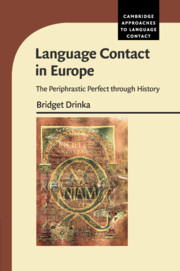Book contents
- Frontmatter
- Contents
- Series Editor's Foreword
- Acknowledgments
- Abbreviations, Based on the Leipzig Glossing Rules
- 1 Language Contact in Europe: The Periphrastic Perfect through History
- 2 Languages in Contact, Areal Linguistics, and the Perfect
- 3 The Perfect as a Category
- 4 Sources of the Perfect in Indo- European
- 5 The Periphrastic Perfect in Greek
- 6 The Periphrastic Perfect in Latin
- 7 The Charlemagne Sprachbund and the Periphrastic Perfects
- 8 The Core and Peripheral Features of the Romance Languages
- 9 The Early Development of the Perfect in the Germanic Languages
- 10 The Semantic Shift of Anterior to Preterite
- 11 The Balkan Perfects: Grammaticalization and Contact
- 12 Byzantium, Orthodoxy, and Old Church Slavonic
- 13 The l- perfect in North Slavic
- 14 Updating the Notion of Sprachbund: New Resultatives and the Circum- Baltic “Stratifi ed Convergence Zone”
- 15 The have Resultative in North Slavic and Baltic
- 16 Conclusions
- Notes
- Bibliography
- Index
9 - The Early Development of the Perfect in the Germanic Languages
Published online by Cambridge University Press: 23 February 2017
- Frontmatter
- Contents
- Series Editor's Foreword
- Acknowledgments
- Abbreviations, Based on the Leipzig Glossing Rules
- 1 Language Contact in Europe: The Periphrastic Perfect through History
- 2 Languages in Contact, Areal Linguistics, and the Perfect
- 3 The Perfect as a Category
- 4 Sources of the Perfect in Indo- European
- 5 The Periphrastic Perfect in Greek
- 6 The Periphrastic Perfect in Latin
- 7 The Charlemagne Sprachbund and the Periphrastic Perfects
- 8 The Core and Peripheral Features of the Romance Languages
- 9 The Early Development of the Perfect in the Germanic Languages
- 10 The Semantic Shift of Anterior to Preterite
- 11 The Balkan Perfects: Grammaticalization and Contact
- 12 Byzantium, Orthodoxy, and Old Church Slavonic
- 13 The l- perfect in North Slavic
- 14 Updating the Notion of Sprachbund: New Resultatives and the Circum- Baltic “Stratifi ed Convergence Zone”
- 15 The have Resultative in North Slavic and Baltic
- 16 Conclusions
- Notes
- Bibliography
- Index
Summary
Introduction
In her important work on the development of aspectual systems in English, Laurel Brinton (1988) notes the similarities of periphrastic perfects across the Germanic languages and makes the following claim about their origin:
If one does not propose a common Germanic provenance for those processes of auxiliation, then it is difficult to explain the appearance of identical auxiliaries in the various Germanic languages, unless one admits independent parallel innovations of an unlikely extent. This I am unwilling to do. (Brinton 1988: 107)
Brinton concludes that auxiliaries in general, and perfect auxiliaries among them, must have arisen in Proto-Germanic times. It will be the focus of this chapter to explore the key issues inherent in this claim: How indeed can we explain the similarities in the periphrastic perfects across many Germanic languages if not by shared inheritance? Are the features that the Germanic languages share only explainable through the notion of genetic relationship? While I am completely sympathetic with Brinton's unwillingness to posit parallel development of identical systems as an explanation, I propose an alternative explanation to her reconstruction of the periphrastic perfects for Proto-Germanic, namely that the Germanic varieties that developed a periphrastic perfect resemble each other so fully because they followed the same model – that of Latin. In the case of Gothic, the oldest well-attested Germanic language, we will find that Greek played the role as “roof” language more extensively than Latin did, but we will also discover that fascinating evidence for the mutual influences of Gothic and Latin exists, as well. What will emerge from our examination here is that the morphosyntactic patterns of Latin served as the template on which the Germanic languages of Western Europe built their perfects.
The dispute as to the origin of Germanic perfects is an old one: in the Grimms’ Deutsches Wörterbuch, Latin is mentioned as the model for the HAVE perfects of Germanic (DWB Bd. 10 Sp. 71). Meillet (1970) likewise suggests that the Germanic languages developed their HAVE perfects based on the influence of Latin: “An important procedure, not yet utilized by Gothic and doubtlessly owing in the beginning to imitation of Vulgar Latin models, is that which consists of uniting the participle with the verb ‘to have’” (Meillet 1970: 70).
- Type
- Chapter
- Information
- Language Contact in EuropeThe Periphrastic Perfect through History, pp. 220 - 254Publisher: Cambridge University PressPrint publication year: 2017



